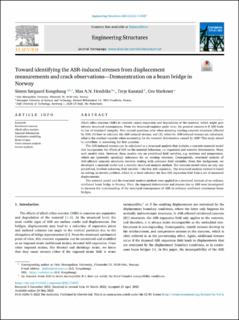Toward identifying the ASR-induced stresses from displacement measurements and crack observations—Demonstration on a beam bridge in Norway
Peer reviewed, Journal article
Published version
Permanent lenke
https://hdl.handle.net/11250/3018523Utgivelsesdato
2022-05-24Metadata
Vis full innførselSamlinger
Originalversjon
https://doi.org/10.1016/j.engstruct.2022.114337Sammendrag
Alkali–silica reaction (ASR) in concrete causes expansion and degradation of the material, which might give adverse structural consequences. From the structural engineer point view, the greatest concern is if ASR leads to loss of structural integrity. Two natural questions arise when assessing existing concrete structures affected by ASR: (1) how to calculate the ASR-induced stresses, and (2), when the ASR-induced stresses are calculated, what is the residual capacity when accounting for the material deterioration caused by ASR? This study aimed to contribute in answering the first question. The ASR-induced stresses can be calculated in a structural analysis that includes a concrete material model that incorporates the effects of ASR on the material behaviour, i.e. expansion and material deterioration. Many such models exist. However, these models rely on predefined field variables, e.g. moisture and temperature, which are (generally speaking) unknowns for an existing structure. Consequently, structural analysis of ASR-affected concrete structures involves dealing with unknown field variables. From this background, we developed a material model and a suitable structural analysis method. The material model relies on only one predefined, howbeit unknown, field variable —the free ASR expansion. The structural analysis method is based on solving an inverse problem, which is to back-calculate the free ASR expansion field from a set of measured displacements. The material model and the structural analysis method were applied in a structural analysis of an ordinary reinforced beam bridge in Norway. Then, the imposed deformations and stresses due to ASR were investigated to increase the understanding of the structural consequences of ASR in ordinary reinforced continuous beam bridges.

